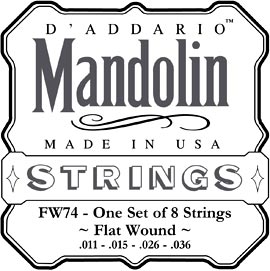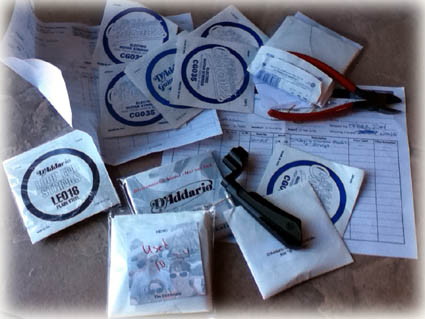« The end of JazzMando JM11 strings |
Main
| Having a ball (end, that is...) »
 July 31, 2013 | About D'Addario FW74 flatwound mandolin strings... July 31, 2013 | About D'Addario FW74 flatwound mandolin strings...
Our supply of JM11 strings is officially depleted. It's premature to give details, but there is a good chance another reputable string dealer will be resurrecting the the line with Labella in the near future. We'll keep you posted.
Meantime, we're resurrecting a story of our own. With the recent street pricing increase of Thomastic flatwounds near $45 a set, this is timely information. Many be be unaware of the D'Addario option, the FW74 set, a string we partnered up with the leading string maker several years ago in developing. From our October 7th, 2010 archives, "The origin of a new string: D'addario FW74."
 D'addario has just introduced a new flatwound mandolin string, and what is not widely known is the impetus and virtually all the intial design started right here with the research staff at JazzMando. We were already well into the successful development and marketing of the Labella JM11 strings, but felt the mandolin market needed a more worldwide distribution chain of economical flatwound strings. Labella was content to make us the wholesale distribution, and we just didn't want to take on that responsibility. D'addario has just introduced a new flatwound mandolin string, and what is not widely known is the impetus and virtually all the intial design started right here with the research staff at JazzMando. We were already well into the successful development and marketing of the Labella JM11 strings, but felt the mandolin market needed a more worldwide distribution chain of economical flatwound strings. Labella was content to make us the wholesale distribution, and we just didn't want to take on that responsibility.
We were already experimenting with the D'Addario chrome series electric guitar single strings on the Epiphone Mandobird and found these strings to be effective on an acoustic mandolin when the balls were removed. We experimented with gauges and discovered we did not have to stray too far from what was working on the JM11s. In essence, D'Addario was already making the FW74, it was a matter of making them with loops instead of balls.
We met with the marketing department three years ago to pitch the idea. Keep in mind a thriving company like D'Addario always has projects on the drawing board for a huge number of stringed instruments, from electric guitar to ukulele, to oud, and once we sold them on the idea, it took many months to actually make it into development. It wasn't as simple as taking the balls off, they had to rework production, because winding a loop end string is still wound differently in manufacturing.

We wanted to see if they could reduce the cost and the inflexibility of playing area length by removing the silk wrapping found on the Labella and Thomastik strings. (Labella requires them in their process.) We found some tailpieces prevented the JM11s from working on all mandolins, and we wanted to remove that barrier with extra length. Unfortunately, it appears the cost savings is not drastic on these, as street pricing is landing in the same range as the Labella, still virtually half the cost of the Thomastik.
FAQ:
Who will be using these?
Flatwound strings are great for closed position fingering, something we advocate strongly. Classical, jazz, and more advance folk playing in the upper frets are arguably more comfortable with these strings, and reducing fatigue in the lower. The tigher wrap also produces more string fundamental, at the expense of bright zingy overtones. These are not a "drone" string, rather they are meant to be played in complex chromatic passages with smoothness and ease.
How much are these in comparision to other flatwound strings; why are they so expensive?
One misconception we need to address is the cost. In actuality, you should get anywhere from two-four times the play out of these with the corrosion resistant tighter winding. This means like the EXP series, if the cost is twice as much, you're getting more life at the same value. (Street price generally $13-15 depending on shipping.)
Are these meant to replace the Thomastik TI series?
Our goal was to come up with a string that was about 1/3 the price and we didn't quite make that. They will be about half, though. They aren't the same string. Some may argue they aren't as rich or warm, but many will like the fact that they actually pack more "ping." In the tonal spectrum, they are closer to sounding like a roundwound string, but maintain the flatwound feel.
Is the A flatwound?
This is a personal preference, and cost issue. Initially we wanted to keep the price down, but we have been prototyping an wound 17 gg string. That's still a little heavy for this set, but they might be available as singles. For now, the FW74 have a plain A string. This worked fine for the majority of our thousands of JM11 customers.
Is this the only gauge they come in?
Initially, we proposed three different sets. We wanted a medium set and a medium light mandolin, but more importantly we wanted an octave mandolin/mandola set. The marketing department wanted to move a little more slowly by introducing one unit at time. This was the compromise, but we hope the other two will come along as these prove market viability.
Do you plan to discontinue the Labella JM11?
Despite the attempts to make this like the JM11 strings, they simply aren't the same. They're not better, not worse, just a tad different. Yes, we've had some issues with E loops, D string cores, and winding lengths, but this three centuries-old company is still run by a family, and each situation was graciously remedied promplty without question and free replacements directly from Labella. The JM11s have the silk winding for locking down in the tuners more quickly, and they still have a bit more complex warmth. With our free shipping, they will probably be the same price as the FW74 if you only order a couple sets at a time and don't need to add more items to your online shopping cart. Frankly, we don't expect the FW series to affect JM sales. We even encourage our existing customers to experiment.
Understand, we have no financial involvement with D'addario Strings, no royalties, no commissions, no consulting fees. Not even free strings. Our goal on this whole project was to make more manufaturers aware of the growing need for the availibilty of flatwound strings. We talked with other string makers, specifically DR Strings, GHS, and Dean Markley, and no one but D'addario would tackle this project. We're already experimenting with other gaugings, including a wound 17 and wound 13, but there's always a distance in time between prototyping and market introduction. Again, our biggers concern is the gap in octave mandolin and mandola strings. We think we have a solution in a set that will fit both instruments, but D'addario needs confidence in their viablity.
We're open to your suggestions. Understand there is no single set that will make everybody happy, but we want to accommodate a broad range of preferences. The FW74 is just the beginnning.
Special thanks to the staff and crew that helped test these, Charlie, Jamie, Barb, Terry, David, and Levi.
Posted by Ted at July 31, 2013 6:10 AM

Disclaimer: In the 'Information Age' of the 21st Century,
any fool with a computer, a modem, and an idea can
become a self-professed 'expert." This site does not
come equipped with 'discernment.'
|



